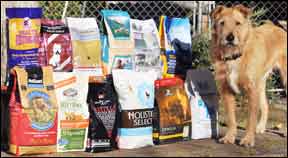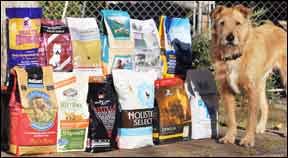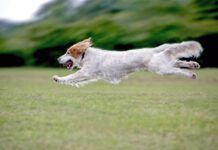In every one of Whole Dog Journal’s canned and dry dog food reviews, we tell you how to identify the hallmarks of a top dry dog food as well as the attributes of a low-quality food. In “Whole Dog Journal’s 2012 Dry Dog Food Review,” we tell you what specific parts of the dog food label you need to scrutinize to make sure the product is a high-quality, “complete and balanced” diet. We also list some 48 companies that make, between them, hundreds of foods that meet all of our selection criteria for a top-quality dry dog food; those products are listed, each with a highlighted example, in the February issue.

288
Now it’s time to look at the label of the food you’ve already been feeding to your dog. How does it compare to a top dry dog food?
If you bought your dog’s food at a grocery store or a big box store, or it was one of the lowest-cost foods you were able to find, it will probably compare very poorly to the foods on our “top dry dog foods” list.
Now take a good long look at your dog. Is she the quintessential “picture of health”? Lean, fit, mentally sharp, with a glossy coat, clear eyes, and a reasonably pleasant odor? Are her poops medium-firm, neither rock hard nor gloppy piles of goop? If not – if she’s fat or too-thin, her coat is a smelly, greasy, or patchy mess, and she’s prone to itching, sores, incessant self-grooming, weepy eyes, endless farting, constipation or diarrhea, you need to choose a new food! All of these are unhealthy conditions that will improve with a better diet.
You can use the information in the “2012 Dry Dog Food Review” for tips on what you should look for in an improved diet for your dog – or look out for, in the case of undesirable attributes. (You could also use our list of “approved foods” as a reliable source of good candidates for improving your dog’s health.)
Once you know how to identify a top dry dog food, it’s important to choose the right good food for your indi-vidual dog. Dogs, like us, are individuals; what works for your overweight Labrador will not be appropriate for my high-energy hunting dog. Your dog may have an allergy or be unable to tolerate a certain ingredient or even several ingredients. The point is, you shouldn’t buy just any good food; your purchase should be customized to your individual dog’s needs. The following are some conditions that require a particular rationale for your purchase:
-If your dog is overweight, you may not want to switch to a grain-free food that contains (at least) 30 percent fat! Instead, it would make more sense to look for a food with a higher protein content (but not high in fat) than the one you currently feed. The goal is to replace carbs with protein, without increasing fat. Though pet food makers are not required to list the caloric content of their foods, many of them report this information voluntarily, and this can help you determine whether you might need to feed more or less of a particular food.
-If your dog is itchy, look for a limited ingredient food (a single protein and a single carb source, preferably not a grain) that contains none of the ingredients that his current food contains.
-If your dog is too thin, look for a food with a higher fat content, particularly if the food you’re feeding now is low in fat.
-If your dog seems to be losing condition as she ages, look for a food with more protein and higher-quality protein sources than the one she’s eating (chicken and/or chicken meal, rather than chicken by-product meal or corn/corn gluten).
-If your dog is having digestive problems, try foods with less fat, a different protein source, or no grains, de-pending on what works for your dog.
-If your dog is a couch potato, don’t feed high-fat foods.
-If your dog acts hungry all the time, look for a food with higher fat content (and maybe more protein as well).
-If your dog is a picky eater, try rotating foods more often, and offer foods with different protein sources to see which are most appealing.
Adjust As Necessary
You may have been told that it’s bad to switch foods, or you may have had a bad experience when your dog ate something different and unauthorized (by you) and erupted in gas or diarrhea. With most dogs, the more you change foods, the more robust and capable their digestion becomes. When fed a limited diet, the breadth of their production of digestive enzymes and the variety of the bacteria in their guts are reduced. You can speed the adjustment by adding digestive enzymes, probiotic, and prebiotic supplements, to help the gut recolonize itself with digestion-aiding agents.
Then, watch your dog! Let her tell you how the new food works for her. Keep track of what you’ve tried, so you can continue to make adjustments and big improvements in your dog’s diet – and, we hope, huge improvements in her physical condition, mental acuity, and overall energy level.






